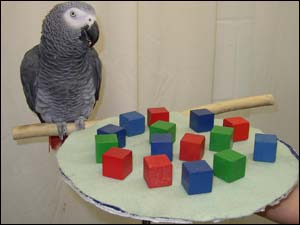African grey parrot is first bird to comprehend numerical concept akin to zero

Ground-breaking research is reshaping understanding of the avian brain and holds promise in teaching learning-disabled children
A Brandeis University researcher has shown that an African grey parrot with a walnut-sized brain understands a numerical concept akin to zero – an abstract notion that humans don’t typically understand until age three or four, and that can significantly challenge learning-disabled children.
Strikingly, Alex, the 28-year-old parrot who lives in a Brandeis lab run by comparative psychologist and cognitive scientist Dr. Irene Pepperberg, spontaneously and correctly used the label “none” during a testing session of his counting skills to describe an absence of a numerical quantity on a tray. This discovery prompted a series of trials in which Alex consistently demonstrated the ability to identify zero quantity by saying the label “none.”
Dr. Pepperberg’s research findings, published in the current issue of The Journal of Comparative Psychology, add to a growing body of scientific evidence that the avian brain, though physically and organizationally somewhat different from the mammalian cortex, is capable of higher cognitive processing than previously thought. Chimpanzees and possibly squirrel monkeys show some understanding of the concept of zero, but Alex is the first bird to demonstrate an understanding of the absence of a numerical set, Dr. Pepperberg noted.
“It is doubtful that Alex’s achievement, or those of some other animals such as chimps, can be completely trained; rather, it seems likely that these skills are based on simpler cognitive abilities they need for survival, such as recognition of more versus less,” explained Dr. Pepperberg.
Alex had previously used the label “none” to describe an absence of similarity or difference between two objects, but he had never been taught the concept of zero quantity. “Alex has a zero-like concept; it’s not identical to ours but he repeatedly showed us that he understands an absence of quantity,” said Dr. Pepperberg.
Historically, the use of “zero” to label a null set has not always been obvious even in human cultures, which in many cases lacked a formal term for zero as recently as the late Middle Ages. The value of number research lies mainly in its ability to help determine the extent of animal cognition and animals’ potential for more complex capacities. To that end, Dr. Pepperberg’s studies on the avian brain are continuing with research into Alex’s ability to count, as well as add and subtract small quantities.
Yet significantly, Dr. Pepperberg’s research, which uses a training method called the model-rival technique, also holds promise for teaching autistic and other learning-disabled children who have difficulty learning language, numerical concepts and even empathy.
The model rival technique involves two trainers, one to give instructions, and one to model correct and incorrect responses and to act as the student’s rival for the trainer’s attention; the model and trainer also exchange roles so that the student sees that the process is fully interactive. The student, in this case, a middle-aged parrot, tries to reproduce the correct behavior. So far, results using this learning technique with small groups of autistic children, taught by Diane Sherman, PhD, in Monterey, CA, have been very promising, said Dr. Pepperberg.
“This kind of research is changing the way we think about birds and intelligence, but it also helps us break down barriers to learning in humans – and the importance of such strides cannot be underestimated,” said Dr. Pepperberg.
Media Contact
More Information:
http://www.brandeis.eduAll latest news from the category: Life Sciences and Chemistry
Articles and reports from the Life Sciences and chemistry area deal with applied and basic research into modern biology, chemistry and human medicine.
Valuable information can be found on a range of life sciences fields including bacteriology, biochemistry, bionics, bioinformatics, biophysics, biotechnology, genetics, geobotany, human biology, marine biology, microbiology, molecular biology, cellular biology, zoology, bioinorganic chemistry, microchemistry and environmental chemistry.
Newest articles

Innovative 3D printed scaffolds offer new hope for bone healing
Researchers at the Institute for Bioengineering of Catalonia have developed novel 3D printed PLA-CaP scaffolds that promote blood vessel formation, ensuring better healing and regeneration of bone tissue. Bone is…

The surprising role of gut infection in Alzheimer’s disease
ASU- and Banner Alzheimer’s Institute-led study implicates link between a common virus and the disease, which travels from the gut to the brain and may be a target for antiviral…

Molecular gardening: New enzymes discovered for protein modification pruning
How deubiquitinases USP53 and USP54 cleave long polyubiquitin chains and how the former is linked to liver disease in children. Deubiquitinases (DUBs) are enzymes used by cells to trim protein…



